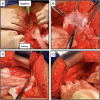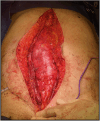Clinical experience and outcomes of post chemotherapy midline extraperitoneal approach to retroperitoneal lymph node dissection
- PMID: 40660198
- PMCID: PMC12257832
- DOI: 10.1186/s12894-025-01853-0
Clinical experience and outcomes of post chemotherapy midline extraperitoneal approach to retroperitoneal lymph node dissection
Abstract
Background: To detail the outcomes of an open midline extraperitoneal (midline EP) approach to post-chemotherapy retroperitoneal lymph node dissection (PC-RPLND) for metastatic testicular cancer.
Methods: We analysed our prospectively maintained operative database from April 2020 to February 2023 for cases of midline EP approach to PC-RPLND, identifying a total of 11 patients across two hospitals in Sydney, Australia. Demographic and perioperative data was obtained from electronic medical records, including preoperative factors such as cancer staging and preoperative treatment.
Results: Eleven patients were included in this study. The median age was 37 years with a median ASA grade of 3. There were a total of six left-sided and five right-sided cases. A modified template was used in eight cases, and a bilateral template was used in three. Tumour staging ranged from Stage IIA- IIIB, with a median maximal retroperitoneal tumour size post chemotherapy of 4.2 cm. Preoperative histology identified 4 cases of seminoma and 7 cases of nonseminomatous germ cell tumours (NSGCT). The median length of the procedure was 300 min, blood loss was 300mL, length of stay was 5 days, and post-operative days until bowel opening was 2 days. The median lymph node yield was 18, with active malignancy identified in five cases. There were four early complications and no late complications. 91% of the patients had preserved ejaculatory function.
Conclusions: The open midline EP approach to PC-RPLND has demonstrated acceptable perioperative outcomes compared to other open surgical approaches, enabling surgeons to complete complex cases. Therefore, the midline EP approach should be considered when performing PC-RPLND.
Keywords: Extraperitoneal; Oncology; Open surgery; RPLND; Testicular Cancer.
© 2025. Crown.
Conflict of interest statement
Declarations. Ethics approval and consent to participate: This study was approved by the Northern Sydney Local Health District - Royal North Shore Hospital Safety and Quality Unit (24-2022). The study was performed in accordance with the Declaration of Helsinki. Informed and written consent was obtained from all patients involved in the study. Consent for Publication: Informed consent was obtained from all patients for the use of their clinical data, pictures and videos. Competing interests: The authors declare no competing interests.
Figures




Similar articles
-
Midline Extraperitoneal Approach to Retroperitoneal Lymph Node Dissection in Testicular Cancer: Minimizing Surgical Morbidity.Eur Urol. 2017 Nov;72(5):814-820. doi: 10.1016/j.eururo.2017.02.024. Epub 2017 Mar 18. Eur Urol. 2017. PMID: 28325537
-
Robot-assisted retroperitoneal lymph node dissection: a systematic review of perioperative outcomes.BJU Int. 2023 Jul;132(1):9-30. doi: 10.1111/bju.15986. Epub 2023 Mar 9. BJU Int. 2023. PMID: 36754376
-
Treatment Outcomes for Men with Clinical Stage II Nonseminomatous Germ Cell Tumours Treated with Primary Retroperitoneal Lymph Node Dissection: A Systematic Review.Eur Urol Focus. 2023 May;9(3):541-546. doi: 10.1016/j.euf.2022.11.003. Epub 2022 Nov 12. Eur Urol Focus. 2023. PMID: 36379869
-
Primary retroperitoneal lymph node dissection in stage II testicular seminoma: a systematic review.BJU Int. 2025 Feb;135(2):214-221. doi: 10.1111/bju.16536. Epub 2024 Oct 24. BJU Int. 2025. PMID: 39448381
-
The perioperative outcomes of retroperitoneal lymph node dissection in Germany for patients with testicular cancer: Results from the GRAND study.Int J Cancer. 2025 Oct 1;157(7):1333-1341. doi: 10.1002/ijc.35486. Epub 2025 Jun 4. Int J Cancer. 2025. PMID: 40464407 Free PMC article.
References
-
- Siegel RL, Miller KD, Wagle NS, Jemal A. Cancer statistics. CA Cancer J Clin. 2023;73(1):17–48. - PubMed
-
- Kim P, Syan-Bhanvadia S, Djaladat H, Faber K, Tadros NN, Nichols C, et al. Midline extraperitoneal approach for retroperitoneal lymph node dissection for testicular germ cell tumor. Urology. 2012;80(4):941–5. - PubMed
-
- Baniel J, Sella A. Complications of retroperitoneal lymph node dissection in testicular cancer: primary and post-chemotherapy. Semin Surg Oncol. 1999;17(4):263–7. - PubMed
-
- Williams SB, McDermott DW, Winston D, Bahnson E, Berry AM, Steele GS, et al. Morbidity of open retroperitoneal lymph node dissection for testicular cancer: contemporary perioperative data. BJU Int. 2010;105(7):918–21. - PubMed
MeSH terms
LinkOut - more resources
Full Text Sources
Medical
Miscellaneous

